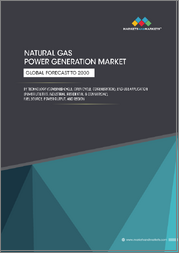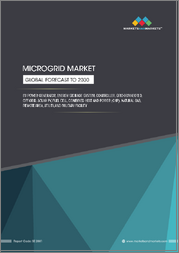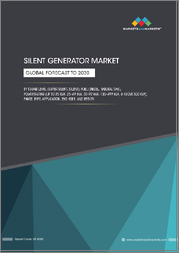
|
시장보고서
상품코드
1422204
건성 천연가스 시장 - 성장, 향후 전망, 경쟁 분석(2023-2031년)Dry Natural Gas Market - Growth, Future Prospects and Competitive Analysis, 2023 - 2031 |
||||||
건성 천연가스 시장은 전력 수요, 가정용 및 산업용 소비, 운송 분야에서의 사용 확대로 인해 2024-2032년 예측 기간 동안 연평균 7.5%의 성장률을 기록할 것으로 예상됩니다. 엑손모빌, 셰브론, 로열더치셸(Royal Dutch Shell)은 이 산업의 미래를 형성하는 데 중요한 역할을 할 준비가 되어 있습니다. 인프라 제약과 규제 이슈가 시장 성장의 걸림돌로 작용하고 있지만, 이러한 문제를 해결하는 것이 시장의 지속적인 성장에 필수적입니다. 지역별로는 아시아태평양과 북미 지역이 성장과 수익 측면에서 리더십을 발휘하고 있는 것으로 나타났습니다. 향후 건성 천연가스 시장은 주요 업체들이 업계의 혁신과 지속가능성을 지속적으로 추진함에 따라 진화할 것으로 예상됩니다.
시장 촉진요인
에너지 수요의 확대
건성 천연가스 시장은 전 세계 에너지 수요 증가에 힘입어 성장하고 있습니다. 사회의 발전과 산업화에 따라 더 깨끗하고 효율적인 에너지원에 대한 수요가 증가하고 있습니다. 메탄을 주성분으로 하는 건성 천연가스는 이러한 수요를 충족시키는 데 중요한 역할을 하는 다목적 연료입니다. 발전, 난방, 산업 공정 등 다양한 분야에서 활용되고 있습니다. 각국이 청정 대체 에너지로 전환함에 따라 건성 천연가스의 수요는 지속적으로 증가하고 있으며, 이는 시장 촉진요인으로 작용하고 있습니다.
환경 규제 및 배출량 감축 목표
엄격한 환경 규제와 온실가스 감축에 대한 전 세계의 노력은 건성 천연가스와 같은 청정 에너지원에 대한 수요를 촉진하고 있습니다. 세계 각국 정부는 이산화탄소 배출을 제한하고 지속가능한 에너지 관행을 장려하는 정책을 시행하고 있습니다. 건성 천연가스는 다른 화석연료에 비해 이산화탄소 배출량이 적은 것으로 알려져 있어 이러한 규제 요건을 충족하는 데 있어 선호되는 대안이 되고 있습니다. 각국이 국제 협약에서 정한 배출량 감축 목표를 달성하기 위해 노력함에 따라, 건성 천연가스 시장은 지속적으로 성장할 것으로 예상됩니다.
탐사 및 생산의 기술 발전
탐사 및 생산 기술의 발전은 건성 천연가스 시장에 혁명을 일으키고 있습니다. 수압파쇄(프래킹)와 수평 시추 등의 기술은 이전에는 경제성이 없다고 여겨졌던 거대한 천연가스 저장층을 열어젖혔습니다. 이러한 기술의 비약적인 발전은 건성 천연가스의 공급량을 증가시켰을 뿐만 아니라 채굴의 비용 효율성도 향상시켰습니다. 지금까지 미개발된 매장량에 접근할 수 있게 된 것은 시장 확대에 크게 기여하여 전 세계 건성 천연가스 공급을 크게 증가시켰습니다. 탐사 및 생산 기술의 지속적인 혁신은 시장의 궤도를 더욱 형성할 것으로 예상됩니다.
억제요인
인프라의 제약과 규제 이슈
양적 성장에도 불구하고, 시장은 인프라 제약과 규제 문제라는 제약 요인에 직면해 있습니다. 천연가스의 운송은 종종 불충분한 파이프라인 인프라로 인해 장애가 발생합니다. 셰브론이 물류 문제를 겪고 있는 것은 이러한 장애요인의 한 예입니다. 또한, 지역마다 다른 규제 역시 산업 확장에 어려움을 겪고 있습니다. 이러한 인프라 제약에 대처하고 복잡한 규제를 극복하는 것은 시장의 지속적인 성장을 위해 필수적입니다.
시장 세분화 분석
공급원별 시장 오프쇼어, 온쇼어
공급원별 시장 세분화에는 근해 및 육상 카테고리가 포함되며, 2023년에는 근해 및 육상 공급원이 모두 시장 수익에 기여하는 데 중요한 역할을 했습니다. 그러나 2024년부터 2032년까지의 예측 기간 동안 해양 공급원이 가장 높은 CAGR을 보이며 가장 높은 수익을 창출할 것으로 예상됩니다. 이러한 변화는 더 깊은 해양 매장량에서 효율적인 추출을 가능하게 하는 기술 발전으로 인해 발생합니다.
최종 용도별 시장 전력, 주택, 운송, 산업, 상업, 기타(석유화학, 항공 등)
최종 용도별로 건성 천연가스의 다양한 용도를 분석하고 있으며, 2023년에는 전력 부문과 산업 부문이 시장 수익에 큰 역할을 했습니다. 그러나 예측 기간 동안 산업 부문은 제조 공정에서 천연가스 수요 증가로 인해 가장 높은 CAGR을 보일 것으로 예상됩니다. 또한, 운송 부문은 연료로 천연가스의 채택이 증가함에 따라 시장 성장에 크게 기여할 것으로 예상됩니다.
북미, 세계 리더의 자리를 유지
지역별 부문에서는 동향, CAGR이 가장 높은 지역, 매출 비중이 가장 높은 지역을 분석합니다. 2023년 아시아태평양은 건식 천연 가스 시장에서 상당한 성장을 보였습니다. 그러나 북미는 대규모 천연가스 생산과 소비에 힘입어 수익률에서 선두를 달리고 있습니다. 중동은 활발한 탐사 활동과 천연가스 수요 증가로 인해 예측 기간 동안 가장 높은 CAGR을 보일 것으로 예상됩니다.
예측 기간 동안 시장 경쟁은 더욱 치열해질 것
2023년에는 엑손모빌, 셰브론, 로열더치셸, EQT 코퍼레이션, 체사피크 에너지, 사우스웨스턴 에너지, 코테라 에너지가 건성 천연가스 시장의 주요 기업으로 부상했습니다. 이들의 탄탄한 탐사 및 생산 활동과 첨단 채굴 기술에 대한 투자가 결합되어 리더로서의 입지를 구축했습니다. 엑손모빌은 LNG 프로젝트에 집중하고, 셰브론은 지속가능한 운영을 위해 노력하고 있으며, 로열더치셸은 전 세계적으로 존재감을 드러내고 있습니다. 중요한 역할을 유지할 것으로 예상됩니다.
목차
제1장 서문
- 보고서 내용
- 보고서 목적
- 대상자
- 주요 제공 상품
- 시장 세분화
- 조사 방법
- 단계 I - 2차 조사
- 단계 II - 1차 조사
- 단계 III - 전문가 패널 리뷰
- 가정
- 채용한 접근법
제2장 주요 요약
제3장 건성 천연가스 시장 : 경쟁 분석
- 주요 벤더의 시장에서의 포지셔닝
- 벤더가 채용하는 전략
- 주요 산업 전략
- 계층 분석 : 2023 vs 2032
제4장 건성 천연가스 시장 : 거시적 분석과 시장 역학
- 서론
- 세계의 건성 천연가스 시장 금액 2022-2032
- 시장 역학
- 시장 성장 촉진요인
- 시장 성장 억제요인
- 주요 과제
- 주요 기회
- 성장 촉진요인과 억제요인의 영향 분석
- See-Saw 분석
- Porter's Five Forces 모델
- 구매자의 교섭력
- 구매자의 교섭력
- 대체품의 위협
- 신규 참여업체의 위협
- 경쟁 기업 간의 경쟁 관계
- PESTEL 분석
- 정치적 상황
- 경제 상황
- 테크놀러지 상황
- 법적 상황
- 사회적 상황
제5장 건성 천연가스 시장 : 공급원별 2022-2032
- 시장 개요
- 성장·매출 분석 : 2023 vs 2032
- 수량과 가격 분석2022-2032
- 시장 세분화
- 오프쇼어
- 온쇼어
제6장 건성 천연가스 시장 : 최종 용도별 2022-2032
- 시장 개요
- 성장·매출 분석 : 2023 vs 2032
- 수량과 가격 분석2022-2032
- 시장 세분화
- 전력
- 주택
- 수송기관
- 산업
- 상업
- 기타(석유화학·항공 등)
제7장 북미의 건성 천연가스 시장 2022-2032
- 시장 개요
- 건성 천연가스 시장 : 공급원별 2022-2032
- 건성 천연가스 시장 : 최종 용도별 2022-2032
- 건성 천연가스 시장 : 지역별 2022-2032
- 북미
- 미국
- 캐나다
- 기타 북미
- 북미
제8장 영국과 유럽연합의 건성 천연가스 시장 2022-2032
- 시장 개요
- 건성 천연가스 시장 : 공급원별 2022-2032
- 건성 천연가스 시장 : 최종 용도별 2022-2032
- 건성 천연가스 시장 : 지역별 2022-2032
- 영국과 유럽연합
- 영국
- 독일
- 스페인
- 이탈리아
- 프랑스
- 기타 유럽
- 영국과 유럽연합
제9장 아시아태평양의 건성 천연가스 시장 2022-2032
- 시장 개요
- 건성 천연가스 시장 : 공급원별 2022-2032
- 건성 천연가스 시장 : 최종 용도별 2022-2032
- 건성 천연가스 시장 : 지역별 2022-2032
- 아시아태평양
- 중국
- 일본
- 인도
- 호주
- 한국
- 기타 아시아태평양
- 아시아태평양
제10장 라틴아메리카의 건성 천연가스 시장 2022-2032
- 시장 개요
- 건성 천연가스 시장 : 공급원별 2022-2032
- 건성 천연가스 시장 : 최종 용도별 2022-2032
- 건성 천연가스 시장 : 지역별 2022-2032
- 라틴아메리카
- 브라질
- 멕시코
- 기타 라틴아메리카
- 라틴아메리카
제11장 중동 및 아프리카의 건성 천연가스 시장 2022-2032
- 시장 개요
- 건성 천연가스 시장 : 공급원별 2022-2032
- 건성 천연가스 시장 : 최종 용도별 2022-2032
- 건성 천연가스 시장 : 지역별 2022-2032
- 중동 및 아프리카
- GCC
- 아프리카
- 기타 중동 및 아프리카
- 중동 및 아프리카
제12장 기업 개요
- ExxonMobil
- Chevron
- Royal Dutch Shell
- EQT Corporation
- Chesapeake Energy
- Southwestern Energy
- Coterra Energy
- 기타 주요 기업
The dry natural gas market is expected to grow at a CAGR of 7.5% during the forecast period of 2024 to 2032, driven by the demand for electric power, residential and industrial consumption, and the expanding use in transportation. ExxonMobil, Chevron, and Royal Dutch Shell are poised to play key roles in shaping the industry's future. While infrastructure limitations and regulatory challenges pose restraints, addressing these issues is crucial for sustained market growth. Geographically, the Asia-Pacific and North America regions stand out, showcasing growth and revenue leadership. Looking ahead, the dry natural gas market is expected to evolve, with key players continuing to drive innovation and sustainability in the industry.
Key Market Drivers
Growing Energy Demand
The dry natural gas market is being propelled by an ever-increasing global demand for energy. As societies advance and industrialize, the need for cleaner and more efficient energy sources intensifies. Dry natural gas, composed mostly of methane, is a versatile fuel that plays a crucial role in meeting this escalating demand. Its application spans various sectors, including electricity generation, heating, and industrial processes. As nations transition towards cleaner energy alternatives, the demand for dry natural gas continues to surge, making it a key driver in the market.
Environmental Regulations and Emission Reduction Goals
Stringent environmental regulations and the global commitment to reduce greenhouse gas emissions are driving the demand for cleaner energy sources like dry natural gas. Governments worldwide are implementing policies to limit carbon emissions and promote sustainable energy practices. Dry natural gas, known for its lower carbon footprint compared to other fossil fuels, becomes a preferred choice in meeting these regulatory requirements. As nations strive to achieve emission reduction goals outlined in international agreements, the market for dry natural gas is expected to witness sustained growth.
Technological Advancements in Exploration and Production
Advancements in exploration and production technologies are revolutionizing the dry natural gas market. Techniques such as hydraulic fracturing (fracking) and horizontal drilling have unlocked vast reservoirs of natural gas previously deemed economically unviable. These technological breakthroughs have not only increased the overall supply of dry natural gas but have also made extraction more cost-effective. The ability to access previously untapped reserves has significantly contributed to the market's expansion, providing a substantial boost to the global supply of dry natural gas. Continued innovation in exploration and production technologies is expected to further shape the trajectory of the market.
Restraint
Infrastructure Limitations and Regulatory Challenges
Despite positive growth, the market faces a restraint in the form of infrastructure limitations and regulatory challenges. The transportation of natural gas often encounters obstacles due to inadequate pipeline infrastructure. Chevron, experiencing logistical challenges, is indicative of this restraint. Additionally, varying regulations across regions pose challenges to the industry's expansion. Addressing these infrastructure limitations and navigating regulatory complexities are critical for sustained market growth.
Market Segmentation Analysis
Market By Source: Offshore, Onshore
The market segmentation by source includes Offshore and Onshore categories. In 2023, both Offshore and Onshore sources played crucial roles in contributing to market revenue. However, during the forecast period from 2024 to 2032, Offshore sources are anticipated to exhibit the highest CAGR and generate the highest revenue. This shift is driven by technological advancements enabling efficient extraction from deeper offshore reserves.
Market By End-use: Electric Power, Residential, Transportation, Industrial, Commercial, Others (Petrochemical, Aviation, etc.)
The segmentation by end-use analyzes the diverse applications of dry natural gas. In 2023, the Electric Power and Industrial sectors played significant roles in market revenue. However, during the forecast period, the Industrial sector is expected to exhibit the highest CAGR, driven by the growing demand for natural gas in manufacturing processes. Additionally, the Transportation sector is anticipated to contribute substantially to market growth due to the increasing adoption of natural gas as a fuel.
North America Remains the Global Leader
The geographic segment analyzes trends, regions with the highest CAGR, and regions with the highest revenue percentage. In 2023, the Asia-Pacific region witnessed substantial growth in the dry natural gas market. However, North America led in terms of revenue percentage, driven by the extensive production and consumption of natural gas. The Middle East is expected to exhibit the highest CAGR during the forecast period, fueled by increasing exploration activities and rising demand for natural gas.
Market Competition to Intensify during the Forecast Period
In 2023, ExxonMobil, Chevron, Royal Dutch Shell, EQT Corporation, Chesapeake Energy, Southwestern Energy, and Coterra Energy emerged as major players in the dry natural gas market. Their robust exploration and production activities, coupled with investments in advanced extraction technologies, positioned them as leaders. ExxonMobil's focus on LNG projects, Chevron's commitment to sustainable practices, and Royal Dutch Shell's global presence contributed significantly to their market dominance. As the industry progresses from 2024 to 2032, these key players are expected to maintain their pivotal roles, emphasizing sustainable practices and technological innovations.
Historical & Forecast Period
This study report represents analysis of each segment from 2021 to 2031 considering 2022 as the base year. Compounded Annual Growth Rate (CAGR) for each of the respective segments estimated for the forecast period of 2023 to 2031.
The current report comprises of quantitative market estimations for each micro market for every geographical region and qualitative market analysis such as micro and macro environment analysis, market trends, competitive intelligence, segment analysis, porters five force model, top winning strategies, top investment markets, emerging trends and technological analysis, case studies, strategic conclusions and recommendations and other key market insights.
Research Methodology
The complete research study was conducted in three phases, namely: secondary research, primary research, and expert panel review. key data point that enables the estimation ofDry Natural Gas market are as follows:
- Research and development budgets of manufacturers and government spending
- Revenues of key companies in the market segment
- Number of end users and consumption volume, price and value.
Geographical revenues generate by countries considered in the report:
Micro and macro environment factors that are currently influencing the Dry Natural Gas market and their expected impact during the forecast period.
Market forecast was performed through proprietary software that analyzes various qualitative and quantitative factors. Growth rate and CAGR were estimated through intensive secondary and primary research. Data triangulation across various data points provides accuracy across various analyzed market segments in the report. Application of both top down and bottom-up approach for validation of market estimation assures logical, methodical and mathematical consistency of the quantitative data.
Market Segmentation
Source
- Offshore
- Onshore
End-Use
- Electric Power
- Residential
- Transportation
- Industrial
- Commercial
- Others (Petrochemical, Aviation, etc.)
Region Segment (2021-2031; US$ Million)
- North America
- U.S.
- Canada
- Rest of North America
- UK and European Union
- UK
- Germany
- Spain
- Italy
- France
- Rest of Europe
- Asia Pacific
- China
- Japan
- India
- Australia
- South Korea
- Rest of Asia Pacific
- Latin America
- Brazil
- Mexico
- Rest of Latin America
- Middle East and Africa
- GCC
- Africa
- Rest of Middle East and Africa
Key questions answered in this report:
- What are the key micro and macro environmental factors that are impacting the growth of Dry Natural Gas market?
- What are the key investment pockets with respect to product segments and geographies currently and during the forecast period?
- Estimated forecast and market projections up to 2031.
- Which segment accounts for the fastest CAGR during the forecast period?
- Which market segment holds a larger market share and why?
- Are low and middle-income economies investing in the Dry Natural Gas market?
- Which is the largest regional market for Dry Natural Gas market?
- What are the market trends and dynamics in emerging markets such as Asia Pacific, Latin America, and Middle East & Africa?
- Which are the key trends driving Dry Natural Gas market growth?
- Who are the key competitors and what are their key strategies to enhance their market presence in the Dry Natural Gas market worldwide?
Table of Contents
1. Preface
- 1.1. Report Description
- 1.1.1. Purpose of the Report
- 1.1.2. Target Audience
- 1.1.3. Key Offerings
- 1.2. Market Segmentation
- 1.3. Research Methodology
- 1.3.1. Phase I - Secondary Research
- 1.3.2. Phase II - Primary Research
- 1.3.3. Phase III - Expert Panel Review
- 1.3.4. Assumptions
- 1.3.5. Approach Adopted
2. Executive Summary
- 2.1. Market Snapshot: Global Dry Natural Gas Market
- 2.2. Global Dry Natural Gas Market, By Source, 2023 (US$ Million)
- 2.3. Global Dry Natural Gas Market, By End-Use, 2023 (US$ Million)
- 2.4. Global Dry Natural Gas Market, By Geography, 2023 (US$ Million)
- 2.5. Attractive Investment Proposition by Geography, 2023
3. Dry Natural Gas Market: Competitive Analysis
- 3.1. Market Positioning of Key Dry Natural Gas Market Vendors
- 3.2. Strategies Adopted by Dry Natural Gas Market Vendors
- 3.3. Key Industry Strategies
- 3.4. Tier Analysis 2023 Versus 2032
4. Dry Natural Gas Market: Macro Analysis & Market Dynamics
- 4.1. Introduction
- 4.2. Global Dry Natural Gas Market Value, 2022 - 2032, (US$ Million)
- 4.3. Market Dynamics
- 4.3.1. Market Drivers
- 4.3.2. Market Restraints
- 4.3.3. Key Challenges
- 4.3.4. Key Opportunities
- 4.4. Impact Analysis of Drivers and Restraints
- 4.5. See-Saw Analysis
- 4.6. Porter's Five Force Model
- 4.6.1. Supplier Power
- 4.6.2. Buyer Power
- 4.6.3. Threat Of Substitutes
- 4.6.4. Threat Of New Entrants
- 4.6.5. Competitive Rivalry
- 4.7. PESTEL Analysis
- 4.7.1. Political Landscape
- 4.7.2. Economic Landscape
- 4.7.3. Technology Landscape
- 4.7.4. Legal Landscape
- 4.7.5. Social Landscape
5. Dry Natural Gas Market: By Source, 2022-2032, USD (Million)
- 5.1. Market Overview
- 5.2. Growth & Revenue Analysis: 2023 Versus 2032
- 5.3. Volume and Pricing Analysis, 2022-2032
- 5.4. Market Segmentation
- 5.4.1. Offshore
- 5.4.2. Onshore
6. Dry Natural Gas Market: By End-Use, 2022-2032, USD (Million)
- 6.1. Market Overview
- 6.2. Growth & Revenue Analysis: 2023 Versus 2032
- 6.3. Volume and Pricing Analysis, 2022-2032
- 6.4. Market Segmentation
- 6.4.1. Electric Power
- 6.4.2. Residential
- 6.4.3. Transportation
- 6.4.4. Industrial
- 6.4.5. Commercial
- 6.4.6. Others (Petrochemical, Aviation, etc.)
7. North America Dry Natural Gas Market, 2022-2032, USD (Million)
- 7.1. Market Overview
- 7.2. Dry Natural Gas Market: By Source, 2022-2032, USD (Million)
- 7.3. Dry Natural Gas Market: By End-Use, 2022-2032, USD (Million)
- 7.4.Dry Natural Gas Market: By Region, 2022-2032, USD (Million)
- 7.4.1.North America
- 7.4.1.1. U.S.
- 7.4.1.1.1. Dry Natural Gas Market: By Source, 2022-2032, USD (Million)
- 7.4.1.1.2. Dry Natural Gas Market: By End-Use, 2022-2032, USD (Million)
- 7.4.1.2. Canada
- 7.4.1.2.1. Dry Natural Gas Market: By Source, 2022-2032, USD (Million)
- 7.4.1.2.2. Dry Natural Gas Market: By End-Use, 2022-2032, USD (Million)
- 7.4.1.3. Rest of North America
- 7.4.1.3.1. Dry Natural Gas Market: By Source, 2022-2032, USD (Million)
- 7.4.1.3.2. Dry Natural Gas Market: By End-Use, 2022-2032, USD (Million)
- 7.4.1.1. U.S.
- 7.4.1.North America
8. UK and European Union Dry Natural Gas Market, 2022-2032, USD (Million)
- 8.1. Market Overview
- 8.2. Dry Natural Gas Market: By Source, 2022-2032, USD (Million)
- 8.3. Dry Natural Gas Market: By End-Use, 2022-2032, USD (Million)
- 8.4.Dry Natural Gas Market: By Region, 2022-2032, USD (Million)
- 8.4.1.UK and European Union
- 8.4.1.1. UK
- 8.4.1.1.1. Dry Natural Gas Market: By Source, 2022-2032, USD (Million)
- 8.4.1.1.2. Dry Natural Gas Market: By End-Use, 2022-2032, USD (Million)
- 8.4.1.2. Germany
- 8.4.1.2.1. Dry Natural Gas Market: By Source, 2022-2032, USD (Million)
- 8.4.1.2.2. Dry Natural Gas Market: By End-Use, 2022-2032, USD (Million)
- 8.4.1.3. Spain
- 8.4.1.3.1. Dry Natural Gas Market: By Source, 2022-2032, USD (Million)
- 8.4.1.3.2. Dry Natural Gas Market: By End-Use, 2022-2032, USD (Million)
- 8.4.1.4. Italy
- 8.4.1.4.1. Dry Natural Gas Market: By Source, 2022-2032, USD (Million)
- 8.4.1.4.2. Dry Natural Gas Market: By End-Use, 2022-2032, USD (Million)
- 8.4.1.5. France
- 8.4.1.5.1. Dry Natural Gas Market: By Source, 2022-2032, USD (Million)
- 8.4.1.5.2. Dry Natural Gas Market: By End-Use, 2022-2032, USD (Million)
- 8.4.1.6. Rest of Europe
- 8.4.1.6.1. Dry Natural Gas Market: By Source, 2022-2032, USD (Million)
- 8.4.1.6.2. Dry Natural Gas Market: By End-Use, 2022-2032, USD (Million)
- 8.4.1.1. UK
- 8.4.1.UK and European Union
9. Asia Pacific Dry Natural Gas Market, 2022-2032, USD (Million)
- 9.1. Market Overview
- 9.2. Dry Natural Gas Market: By Source, 2022-2032, USD (Million)
- 9.3. Dry Natural Gas Market: By End-Use, 2022-2032, USD (Million)
- 9.4.Dry Natural Gas Market: By Region, 2022-2032, USD (Million)
- 9.4.1.Asia Pacific
- 9.4.1.1. China
- 9.4.1.1.1. Dry Natural Gas Market: By Source, 2022-2032, USD (Million)
- 9.4.1.1.2. Dry Natural Gas Market: By End-Use, 2022-2032, USD (Million)
- 9.4.1.2. Japan
- 9.4.1.2.1. Dry Natural Gas Market: By Source, 2022-2032, USD (Million)
- 9.4.1.2.2. Dry Natural Gas Market: By End-Use, 2022-2032, USD (Million)
- 9.4.1.3. India
- 9.4.1.3.1. Dry Natural Gas Market: By Source, 2022-2032, USD (Million)
- 9.4.1.3.2. Dry Natural Gas Market: By End-Use, 2022-2032, USD (Million)
- 9.4.1.4. Australia
- 9.4.1.4.1. Dry Natural Gas Market: By Source, 2022-2032, USD (Million)
- 9.4.1.4.2. Dry Natural Gas Market: By End-Use, 2022-2032, USD (Million)
- 9.4.1.5. South Korea
- 9.4.1.5.1. Dry Natural Gas Market: By Source, 2022-2032, USD (Million)
- 9.4.1.5.2. Dry Natural Gas Market: By End-Use, 2022-2032, USD (Million)
- 9.4.1.6. Rest of Asia Pacific
- 9.4.1.6.1. Dry Natural Gas Market: By Source, 2022-2032, USD (Million)
- 9.4.1.6.2. Dry Natural Gas Market: By End-Use, 2022-2032, USD (Million)
- 9.4.1.1. China
- 9.4.1.Asia Pacific
10. Latin America Dry Natural Gas Market, 2022-2032, USD (Million)
- 10.1. Market Overview
- 10.2. Dry Natural Gas Market: By Source, 2022-2032, USD (Million)
- 10.3. Dry Natural Gas Market: By End-Use, 2022-2032, USD (Million)
- 10.4.Dry Natural Gas Market: By Region, 2022-2032, USD (Million)
- 10.4.1.Latin America
- 10.4.1.1. Brazil
- 10.4.1.1.1. Dry Natural Gas Market: By Source, 2022-2032, USD (Million)
- 10.4.1.1.2. Dry Natural Gas Market: By End-Use, 2022-2032, USD (Million)
- 10.4.1.2. Mexico
- 10.4.1.2.1. Dry Natural Gas Market: By Source, 2022-2032, USD (Million)
- 10.4.1.2.2. Dry Natural Gas Market: By End-Use, 2022-2032, USD (Million)
- 10.4.1.3. Rest of Latin America
- 10.4.1.3.1. Dry Natural Gas Market: By Source, 2022-2032, USD (Million)
- 10.4.1.3.2. Dry Natural Gas Market: By End-Use, 2022-2032, USD (Million)
- 10.4.1.1. Brazil
- 10.4.1.Latin America
11. Middle East and Africa Dry Natural Gas Market, 2022-2032, USD (Million)
- 11.1. Market Overview
- 11.2. Dry Natural Gas Market: By Source, 2022-2032, USD (Million)
- 11.3. Dry Natural Gas Market: By End-Use, 2022-2032, USD (Million)
- 11.4.Dry Natural Gas Market: By Region, 2022-2032, USD (Million)
- 11.4.1.Middle East and Africa
- 11.4.1.1. GCC
- 11.4.1.1.1. Dry Natural Gas Market: By Source, 2022-2032, USD (Million)
- 11.4.1.1.2. Dry Natural Gas Market: By End-Use, 2022-2032, USD (Million)
- 11.4.1.2. Africa
- 11.4.1.2.1. Dry Natural Gas Market: By Source, 2022-2032, USD (Million)
- 11.4.1.2.2. Dry Natural Gas Market: By End-Use, 2022-2032, USD (Million)
- 11.4.1.3. Rest of Middle East and Africa
- 11.4.1.3.1. Dry Natural Gas Market: By Source, 2022-2032, USD (Million)
- 11.4.1.3.2. Dry Natural Gas Market: By End-Use, 2022-2032, USD (Million)
- 11.4.1.1. GCC
- 11.4.1.Middle East and Africa
12. Company Profile
- 12.1. ExxonMobil
- 12.1.1. Company Overview
- 12.1.2. Financial Performance
- 12.1.3. Product Portfolio
- 12.1.4. Strategic Initiatives
- 12.2. Chevron
- 12.2.1. Company Overview
- 12.2.2. Financial Performance
- 12.2.3. Product Portfolio
- 12.2.4. Strategic Initiatives
- 12.3. Royal Dutch Shell
- 12.3.1. Company Overview
- 12.3.2. Financial Performance
- 12.3.3. Product Portfolio
- 12.3.4. Strategic Initiatives
- 12.4. EQT Corporation
- 12.4.1. Company Overview
- 12.4.2. Financial Performance
- 12.4.3. Product Portfolio
- 12.4.4. Strategic Initiatives
- 12.5. Chesapeake Energy
- 12.5.1. Company Overview
- 12.5.2. Financial Performance
- 12.5.3. Product Portfolio
- 12.5.4. Strategic Initiatives
- 12.6. Southwestern Energy
- 12.6.1. Company Overview
- 12.6.2. Financial Performance
- 12.6.3. Product Portfolio
- 12.6.4. Strategic Initiatives
- 12.7. Coterra Energy
- 12.7.1. Company Overview
- 12.7.2. Financial Performance
- 12.7.3. Product Portfolio
- 12.7.4. Strategic Initiatives
- 12.8. Other Notable Players
- 12.8.1. Company Overview
- 12.8.2. Financial Performance
- 12.8.3. Product Portfolio
- 12.8.4. Strategic Initiatives




















